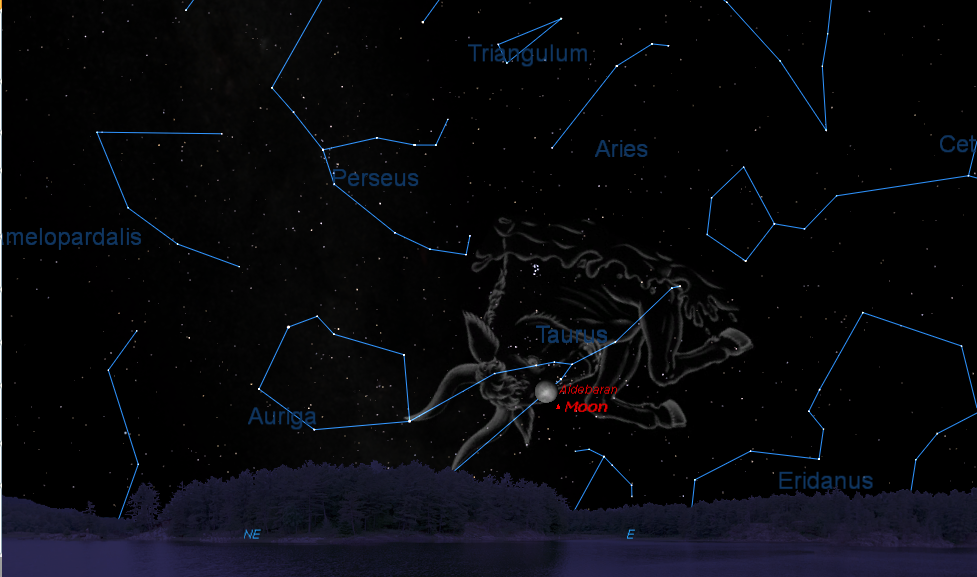The Moon Will Hide a 'Bull's Eye' Star Tonight: How to See It

Tonight (Nov. 5),just one day after reaching its full phase for the month, the moon will temporarily hide the orange star Aldebaran, the brightest star in the constellation Taurus, in what astronomers call an occultation.
Eastern U.S. observers as far south as Miami will see the whole thing, while observers west of the region of visibility (which covers roughly the eastern half of North America) will catch the latter half. Observers east of the Atlantic can catch the event while the moon is higher in the sky, weather permitting. [The Moon's Aldebaran Occultation Explained: What to Know]
For skywatchers in New York City, the occultation will start at 8:01 p.m. EST and end at 8:56 p.m. EST. Chicagoans will see it begin at 7:03 p.m. CST and end at about 7:55 p.m. CST. From New Orleans, only the end of the occultation will be visible at 7:38 p.m. local time, when Aldebaran reappears. (Moonrise occurs at 6:51 p.m., and by that time, the star will already be behind the moon.) In Miami, Aldebaran disappears at 7:50 p.m. EST and reappears at 8:27 p.m. EST.
New Yorkers will have a bit more difficulty seeing the moon because it will be only about 16 degrees above the horizon in the eastern sky, so it will be imperative to get away from tall buildings. (For reference, your closed fist held out at arm's length covers about 10 degrees of the night sky.) In Chicago, the moon will be only about 7 degrees above the horizon.
Farther south, the viewing situation will be not much better, as the moonwill have just risen and will be only 6 degrees in altitude; the best places to see it might be on the beach, looking out over the Atlantic.
On the other side of the Atlantic, Londoners will see Aldebaran disappear at 2:38 a.m. local time on Monday (Nov. 6) and end at 3:23 a.m. In Paris, observers will catch it at 3:51 a.m.; it will end there at 4:20 a.m. For both cities, the moon will be positioned high in the sky. In London, the moon will be 53 degrees above the horizon, and in Paris, the apparent location will be similar.
The zone of visibility's southern limit runs through Cuba, and observers there might catch a grazing occultation on the eastern part of the island. A similar setup occurs in Europe, south of Munich and in the Alps. Maps showing the "graze line" can be found here and here.
Get the Space.com Newsletter
Breaking space news, the latest updates on rocket launches, skywatching events and more!
Editor's note: If you snap a great photo of the moon, Aldebaran or any other night-sky sight you'd like to share with Space.com and our news partners for a story or image gallery, send images and comments to spacephotos@space.com.
You can follow Space.com on Twitter @Spacedotcom. We're also on Facebook & Google+. Original story on Space.com.
Join our Space Forums to keep talking space on the latest missions, night sky and more! And if you have a news tip, correction or comment, let us know at: community@space.com.

Jesse Emspak is a freelance journalist who has contributed to several publications, including Space.com, Scientific American, New Scientist, Smithsonian.com and Undark. He focuses on physics and cool technologies but has been known to write about the odder stories of human health and science as it relates to culture. Jesse has a Master of Arts from the University of California, Berkeley School of Journalism, and a Bachelor of Arts from the University of Rochester. Jesse spent years covering finance and cut his teeth at local newspapers, working local politics and police beats. Jesse likes to stay active and holds a fourth degree black belt in Karate, which just means he now knows how much he has to learn and the importance of good teaching.









